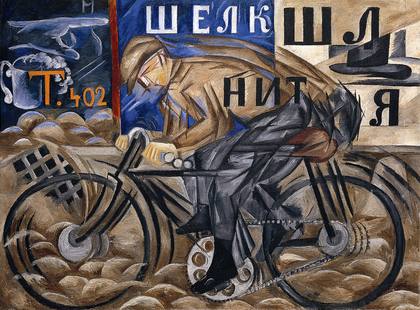the Apocalypse has always held a particular fascination in the American imagination from religious fundamentalism to secular fear-mongers of nuclear holocaust, new age warnings of environmental apocalypse and economic armageddon because of greedy bankers and those sneaky poor who cheat on food stamps or default on mortgages. There is almost a perverse joy in the death wish, a hyper-romanticism bathing in the cold sun of nihilism picking through the scraps the morning after. Te flip side of Ronald Reagan’s “new dawn in America.” And there is no shortage of prophets who claim to have their mouth to god’s ear in a metaphor for erotic what the french call “petits morts” ejaculation of faith based religious ecstasy in the face of reason and a modicum of common sense.

---In many ways, the term 'Clash of Civilizations' contains the seeds of a most comprehensive truth. I am afraid though that we will have to come to terms with the fact, that the lines will prove to be much more blurred and drawn criss-cross throughout our society. Just when we reluctantly acknowledge the reality of a long-drawn-out conflict centering around religious beliefs; just when we thought that the factions could be limited to those of Judea-Christian beliefs versus Islamic ones, must we realize, that the scope is far wider: Faith versus Skepticism with all its variations such as cynicism, pessimism, disbelief, agnosticism, atheism, and anti-Semitism. In short, the rejection of all religious and moral principles, often in the belief that life is meaningless, otherwise called Nihilism.--- Read More:http://www.allthingsbeautiful.com/all_things_beautiful/2006/05/restoring_humil.html
So, there is a contemporary fascination, really a repackaging of the aesthetic of fear and catastrophe as a central organizing concept of the American psyche. Its particular local mutation is its movement back towards traditional beliefs about the unique role and destiny of the U.S. in which civil religion underpins American civilization with an historical association with millennialist ideas. But even back in the age of the romantic poets, of Keats, Shelley and Byron, people beleived that the apocalypse was very near, claimed evidence of the end everywhere, and were rock-solid certain about the irremediable coming of the end of times, and, two centuries later, we are thinking the same with events like Haiti or stravation in Africa being the canary in the coal mine menacing the idyllic white picket fences.
There is a new television show called Livin’ For The Apocalypse in which four couples are profiled in preparing for Armageddon that is at close quarters and inexorably moving with humanity’s faith in progress. One couple is not exactly sure what form the Beast will take but the dwelling is jammed with food and the man of the house is armed with anough weapons to form a respectable militia. Of interest also is a chiropractor, the Survival Doc, who animates an on-line show dealing with survivalism which underscores the point that fear that feed the survivalist industry “trickles down”or up in the food chain and is responsible for much of rampant consumerism, the racism it engenders and the primordial desire to possess material objects in situations that are deemed beyond control.

---Futurism, for instance, sought to overcome the past and promoted technological elements of the future with an intent to bludgeon the public with shock effects. Futurism We must break down the gates of life to test the bolts and the padlocks! Let us go! Here is the very first sunrise on earth! Nothing equals the splendor of its red sword which strikes for the first time in our millennial darkness." – F. T. Marinetti, 1909---Read More:http://www.counterorder.com/art.html image:http://www.bbc.co.uk/radio4/features/front-row/galleries/futurism/index.shtml?gp=2
ADDENDUM:

---Livin’ for the Apocalypse steadfastly refuses to acknowledge fear, because doing so would remove it from the realm of casual entertainment. “Quirky,” one-dimensional characters, by contrast, entertain viewers from a safe remove, so we never have to think through the deeply serious issues implied by what they say. When another preparer says that, after the ill-defined apocalypse, “I’m not a cannibal, but it might come to that,” it’s easy to laugh. It’s harder to know why someone would choose to live that way. Yet as Michael Shermer points out, “Emotionally, the end of the world is actually a renewal, a transition to a new beginning and a better life to come.” Even within the show’s limitations, it’s impossible to miss the strong emotional investment these people have in the end of the world—or rather, the end of a world. Clustered in the American west and southwest, where the myth of frontier individualism remains potent as ever, they imagine themselves building for a post-society world, for a war of all against all, or at best a neo-tribalism. When one subject says, “The world as we know it, and especially our country, is coming to an end,” it’s hard not to catch a note of gleeful superiority in her words. She will be one of the elect, the chosen few who survive: livin’ for the apocalypse, then, means dreaming of another world in order to get by in this one. --- Read More:http://www.popmatters.com/pm/review/146752-livin-for-the-apocalypse
To premillenarians, like Harold Camping, the end of the world is beyond the human scale of control. Rather, it is driven by a higher, divine system of order. From this viewpoint, we are not responsible for the wars, environmental crises, or economic issues we face: these are all signs of the end times, a reason for us to release our worldly concerns and focus instead on repentance. For postmillenarians, however, we are indeed responsible for the problems we face, and thus also responsible for formulating solutions; the apocalypse exists within the human scale of control. Instead of looking to religion or spirituality for answers or relief, the postmillenarian viewpoint compels us to turn to technology, to science, and to ingenuity for answers.Read More:http://mediacommons.futureofthebook.org/imr/2011/06/06/end-horrible-technology-and-apocalypse
———————————–

---Benjamin tried to present this theme in The Work of Art in the Age of Technological Reproduction. He concluded this essay in saying: "Mankind, which in Homer's time was an object of contemplation for the Olympian Gods, now is one for itself. Its self-alienation has reached such a degree that it can experience its own destruction as an aesthetic pleasure of the first order". It is worth noting the correspondence of Marcuse's critique - The One-Dimensional Man - and Horkheimer's critique - "the administered world." Both describe a totalitarian reality, a reality encompassing the pleasure industry and technological progress in general. In my opinion, the crucial issue for Horkheimer, as well as for Adorno and Benjamin - unlike Marcuse - is that this technological society is nothing but a particular historical expression of an element situated at the basis of Being in general. For Adorno "space is nothing but absolute alienation". This is the basis for the whole historical reality of the advanced technological society, in which everything has become "consumption" and life with all its layers and dimensions is nothing but a 'fetish of consumption". Benjamin did not hesitate to designate "the totality" of "modernity" using a distinct name: "hell." Hell returns, again and again, in each innovation, and surely this totality reflects the "eternity of hell upon earth". Read More:http://construct.haifa.ac.il/~ilangz/Utopia4.html
These goals stand in opposition to the struggle for the language of paradise and for varnishing the goal-driven self, history, politics and, implicitly, the concept of revolution contaminated by the present order. The dimension linking positive utopianism and the thought of redemption is clarified in Benjamin’s negative utopianism and in the philosophical struggle (as a serious aesthetic game) for the salvation of the soul, which assumes the state of redemption and demands the negative utopian struggle. However, it is already possible to point to the clearly Cabalistic dimension merging into Benjamin’s thought, whose yearning for the eternal, for the completely other, suppresses the temporal, the political, the ever-transient within reality. The appropriate political attitude is defined as “nihilion”. Read More:http://construct.haifa.ac.il/~ilangz/Utopia4.html
Byron ( Darkness, 1816):…
37 Hissing, but stingless–they were slain for food.
38 And War, which for a moment was no more,
39 Did glut himself again: a meal was bought
40 With blood, and each sate sullenly apart
41 Gorging himself in gloom: no love was left;
42 All earth was but one thought–and that was death
43 Immediate and inglorious; and the pang
44 Of famine fed upon all entrails–men
45 Died, and their bones were tombless as their flesh;
46 The meagre by the meagre were devour’d,
47 Even dogs assail’d their masters, all save one,
48 And he was faithful to a corse, and kept
49 The birds and beasts and famish’d men at bay,
50 Till hunger clung them, or the dropping dead
51 Lur’d their lank jaws; himself sought out no food,
52 But with a piteous and perpetual moan,
53 And a quick desolate cry, licking the hand
54 Which answer’d not with a caress–he died.
55 The crowd was famish’d by degrees; but two
56 Of an enormous city did survive,
57 And they were enemies: they met beside
58 The dying embers of an altar-place…
There are features that can be seen as some kind of biblical language announcing the apocalypse (2) like that of the snakes and, at some verses, men are seen as devils:
“The brows of men by the despairing light
Wore an unearthly aspect, as by fits
The flashes fell upon them; some lay down” (22:24)
With this vision of men as devils, Byron “is communicating that fear: that God is not in nature or in us; that he is not at all; that ‘Darkness (or nature) had no need / of aid from them–She was the Universe’”. In conclusion with the analysis, it is a poem with a depressing and catastrophic mood, full of imagery about the end of times, cities set on fire, humans as beasts, the transition from slow movement at the beginning, fast and chaotic in the middle to once again slow at the end, from life to death, from light to darkness.
This atmosphere of tragedy is influence by Byron’s own depression, his cynical view of the humanity because “he allows man no dignity at all in his final hours”. Read More:http://mural.uv.es/perova/byron.html





 COMMENTS
COMMENTS